Samsung GT-I8000 Omnia II Review
Samsung GT-I8000 Omnia II
With its high resolution OLED screen and impressive multimedia abilities, this phone has potential.
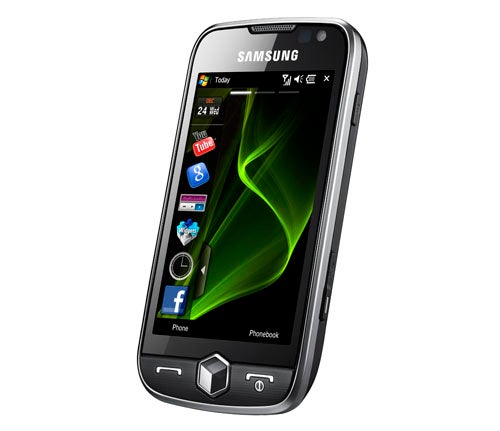
Verdict
Key Specifications
- Review Price: £344.67
Samsung’s Omnia handset was a pretty popular smartphone when it was originally released, but the march of time is never kind to phones so an update is more than a little overdue. With the Omnia II Samsung is hoping to make up for lost time by kitting the handset out with a faster processor, OLED screen and a host of interesting multimedia features. 
As with the original model, Samsung has gone for Microsoft’s Windows Mobile OS on this update. Sadly it’s not used the brand new Windows Phone 7 Series but does have the latest iteration of the 6 series, which boasts an improved interface that’s been tweaked for touch input. The new Lock screen and Start menus work really well, but there are still too many fiddly option screens for our tastes.
Perhaps mindful of this, Samsung has decided to slap its own Touchwhiz interface over the top. This looks virtually identical to the interface it uses on its non-Windows touchscreen phones. For example, its home screen is split into three sliding panels. On the left hand side of each of these panels there’s a pull-out tab that reveals a number of widgets that can be dragged and dropped anywhere on the home screen panels. You can freely move widgets between different panels to arrange them exactly as you want. Samsung includes quite a lot of widgets by default ranging from one that provides a neat looking mobile news feed from CNN to a handy mini media player. However, some of entries that seem to be widgets, such as the ones for MySpace and YouTube, turn out to be little more than shortcuts to these websites, which is rather disappointing.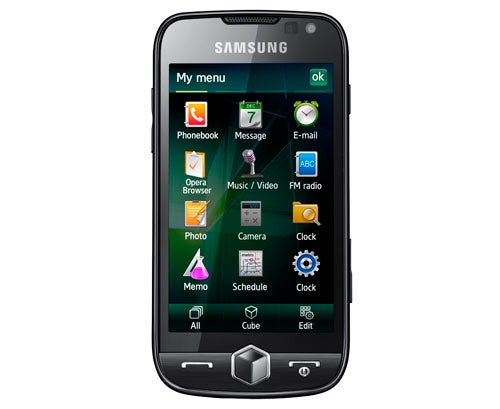
One of the phone’s headline features is its Organic LED screen. Thanks to there use of individual LEDs for each pixel and there lack of a light absorbing LCD layer, they boast higher contrast ratios and better viewing angles than traditional displays. The lack of a backlight also means they are potentially much more power efficient. However, this isn’t always the case as often they draw more power than an LCD when displaying lots of white pixels (when you’re viewing a web page for example).
It’s pretty obvious that Samsung has tweaked the backgrounds on the phone to try to avoid this. Whereas most Windows Phones use black text on a white background for displaying menus and settings screens, the Omnia II tends to show these as white text on a dark or black background. It’s not a massive deal, but it is noticeable and looks a little less clean to our eye. 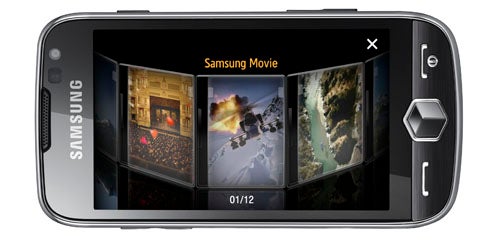
Another issue with OLED screens is that although they look very bright indoors, outdoors their performance isn’t usually as good as LCD. Thankfully the one Samsung has used here doesn’t suffer too badly from this issue. Outdoors back to back with an iPhone 2G , the Omnia II doesn’t look too much darker. And indoors the Omnia’s screen clearly has the advantage as the contrast is excellent and colours are really in your face. The fact that at 3.7in it’s larger than the one on the iPhone and also has a higher resolution of 800 x 480 pixels obviously helps too.
However, when it comes to touch input it lags behind Apple’s handset as it uses resistive rather than capacitive technology, so doesn’t respond to the lightest of touches and requires a bit of pressure to be sensed. It also lacks the multi touch capabilities of phones like the Hero and iPhone.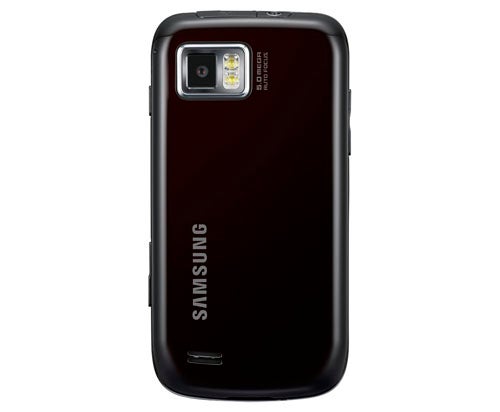
Samsung has used an 800MHz ARM processor on the phone so we were expecting it to be quite speedy, but unfortunately this isn’t really the case. It’s fine for browsing the web or watching video clips, but it can be alarmingly slow when moving though the menus or homescreen panels. For example, when swiping between panels it takes a second or two to redraw any widgets that you’ve got resting on them. It certainly makes us think that Samsung should have opted for a faster chip, like the 1GHz Snapdragon processor that’s appearing on more and more Windows Phone handsets, or perhaps toned down its TouchWiz interface.
On the plus side, multimedia support is good. There’s a standard headphone jack positioned on the top edge of the phone and the supplied headphones are a cut above those you usually get with these types of handsets. The phone’s 5.0megapixel camera is also impressive. It’s got autofocus and a twin LED flash and captured shots look sharp and have pretty accurate looking colours. The camera application also has a range of neat features including face and smile detection. It shoots impressive video too, managing to capture 720 x 480 pixel clips at an impressive 30 frames a second. 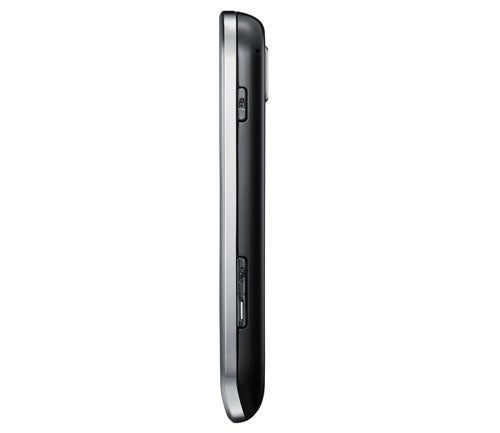
Samsung has also done a good job on its media playing app. It makes it a cinch to navigate around your music library and supports a decent range of video formats. For example, it easily handles standard definition Dixv files, so you don’t have to re-encoded them to a lower res to make them playable. There’s also a few games preloaded including the Asphalt 4 HD racing game. However, the 3D graphics in this are quite blocky and a long way of the fluidity of Real Racing on the iPhone for example. Another interesting software addition is the Connect Home application that lets you stream music, video or pictures over Wi-Fi from a PC or NAS that’s running a UPnP media server. This is surprisingly easy to use, as it found both our PC and NAS without needing any configuration and happily streamed standard definition DivX files across our network without any stuttering or elongated buffering.
In fact connectivity is one of the handset strong points as it has HSDPA, Wi-Fi, Bluetooth and GPS onboard. The GPS worked great with Googlemaps and the phone’s camera software also support geotagging, which is pretty neat. The phone’s call quality was also excellent as the ear piece delivers loud and crisp audio while the microphone also isn’t overly directional so you don’t have to consciously position your mouth next to it as you do with the iPhone. And like the iPhone it has a proximity sensor so it turns off the display when you’re holding it to your ear on a call and turns it on again as you move it away from your head. Another neat feature is that if the handset is lying flat on a desk and you get an incoming call, simply flipping it over will set the phone to mute and flipping it back will unmute it again.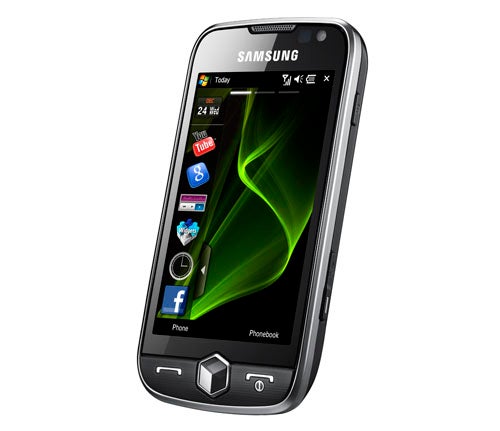
Unfortunately if you were expecting that OLED screen to add significantly to this phone’s battery life you’ll be sorely disappointed. The battery life isn’t exactly bad – we got around a day and half’s usage from it – but it’s just not any different to most other Windows Mobile devices on the market right now.
”’Verdict”’
Overall, the Omnia II impresses with its neat design, bright screen, good multimedia features and well rounded connectivity options. However, its sluggish processor lets the side down and with more and more speedy Snapdragon based phones appearing on the market, that’s quite a major issue in our book.
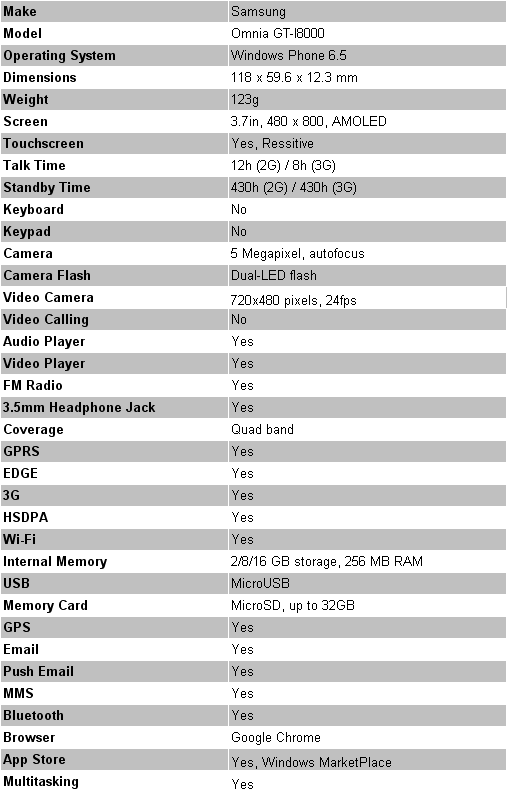
How we test phones
We test every mobile phone we review thoroughly. We use industry standard tests to compare features properly and we use the phone as our main device over the review period. We’ll always tell you what we find and we never, ever, accept money to review a product.
Trusted Score
Score in detail
-
Performance 6
-
Design 8
-
Value 7
-
Features 8
General
| Operating System | Windows Phone |
| Height (Millimeter) | 118mm |
| Width (Millimeter) | 59.6mm |
| Depth (Millimeter) | 12.3mm |
| Weight (Gram) | 123g |
| Available Colours | Black, white, pink |
Display
| Screen Size (inches) (Inch) | 3.7in |
| Screen Resolution | 480x800 |
| Touchscreen | Yes |
Battery
| Talk Time (Minute) | 480m |
| Standby Time (Hour) | 430hr |
Storage
| Internal Storage (Gigabyte) | 0.512GB |
| Camera (Megapixel) | 5 Megapixel |
| Front Facing Camera (Megapixel) | 0.6 Megapixel |
| Camera Flash | dual-LED |
Connectivity
| Bluetooth | Yes |
| WiFi | Yes |
| 3G/4G | Yes |
| 3.5mm Headphone Jack | Yes |
| Charging/Computer Connection | microUSB |
Processor and Internal Specs
| CPU | 800MHz |
Misc
| GPS | Yes |

